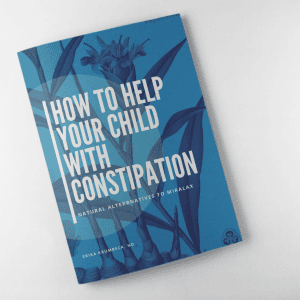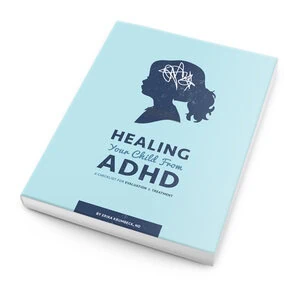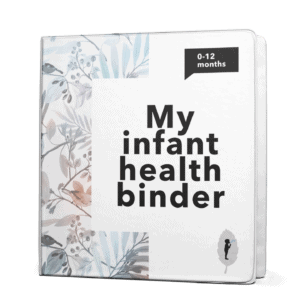Petasites (Butterbur) for Kids with Migraines: What Parents Should Know
Are you a healthcare provider? Read our research summary of Petasites (Butterbur) on Naturopathic Pediatrics PRO, our website for professionals.
If your child struggles with migraines, you’re not alone—and you may be wondering if there are natural, safe alternatives to conventional medications. One herb that’s been gaining attention is butterbur (Petasites hybridus), a traditional European plant with a history of use for headaches, allergies, and more.
In this article, we’ll explore what butterbur is, how it may help with pediatric migraines, and what parents need to know about using it safely.
Disclaimer: This blog post is for educational purposes only and is not a substitute for medical advice. Always consult your child’s healthcare provider before starting any new supplement or treatment, especially herbal products like butterbur.
What Is Butterbur?
Butterbur is a large-leafed plant native to Europe and parts of Asia. Historically, people used its leaves to wrap butter (hence the name) and its root to treat a variety of ailments—from coughs and asthma to headaches and digestive issues.
Modern research has focused on its benefits for:
- Migraines
- Seasonal allergies (hay fever)
- Anxiety and mild depression
For children who suffer from migraines, butterbur is of special interest because of its natural anti-inflammatory and pain-modulating properties.
How Butterbur Might Help with Migraines
Butterbur contains two key compounds—petasin and isopetasin—that appear to help prevent migraines by:
- Reducing inflammation: Butterbur blocks inflammatory chemicals that play a role in migraine attacks.
- Calming nerve pathways: It reduces activity in pain-sensing nerves involved in migraines.
- Blocking calcium channels: This may help prevent the transmission of pain signals in the brain.
- Protecting brain cells: Butterbur also contains antioxidants that reduce oxidative stress, a factor in many neurological conditions.
These effects make butterbur an appealing option for families exploring natural approaches to migraine prevention.
Is Butterbur Safe for Children?
Safety is one of the most important things to consider with butterbur. The raw plant contains pyrrolizidine alkaloids (PAs), compounds that can damage the liver and lungs. However, high-quality supplements are carefully purified to remove these toxic compounds.
If you choose to try butterbur, look for a PA-free product, such as Petadolex®, which has been studied in both adults and children.
That said, some children may still experience mild side effects like:
- Burping or upset stomach
- Drowsiness
- Headaches
- Allergic reactions (especially if sensitive to plants like ragweed or daisies)
Some healthcare providers recommend checking liver enzymes before starting butterbur, and again periodically during use—especially if it will be used long-term.
- Product on sale
 How to Help Your Child with Constipation – Natural Alternatives to Miralax (E-book)Original price was: $25.00.$15.00Current price is: $15.00.
How to Help Your Child with Constipation – Natural Alternatives to Miralax (E-book)Original price was: $25.00.$15.00Current price is: $15.00. - Product on sale
 Healing your child from ADHD (E-Book)Original price was: $25.00.$15.00Current price is: $15.00.
Healing your child from ADHD (E-Book)Original price was: $25.00.$15.00Current price is: $15.00. -
 My Infant Health Binder (Printable E-book)$18.00
My Infant Health Binder (Printable E-book)$18.00
What Does the Research Say?
Here’s a quick look at some of the clinical studies supporting butterbur’s use in pediatric and adult migraine prevention:
- Children’s study (Oelkers-Ax, 2008): Children who took butterbur (50–150 mg daily) had significantly fewer migraines than those who received a placebo. Over 75% of kids improved.
- Adult study (Lipton, 2004): Adults taking 150 mg daily of Petadolex® saw a 48% reduction in migraine frequency.
- Adult study (Grossman, 2001): 45% of patients taking butterbur had a major drop in migraine frequency, compared to only 15% with placebo.
While more research in children is still needed, these studies suggest that butterbur can be a useful addition to migraine prevention plans.
How to Use Butterbur Safely
If you’re considering trying butterbur for your child, first, make sure to discuss with your child’s healthcare provider. This treatment is not right for all patients. It is very important when using Butterbur to:
- ✅ Choose a PA-free product (e.g., Petadolex®)
- ✅ Use the right dose (typically 50–150 mg/day, depending on age/weight)
- ✅ Watch for side effects, especially digestive or allergic reactions
- ✅ Consider liver testing before and during use for added safety
Final Thoughts
Butterbur is a promising natural option for preventing migraines in children, especially when other treatments haven’t worked well. It’s not a first-line treatment in most cases—but it may be a helpful tool when used thoughtfully and under medical guidance.
In my own practice, I often begin with identifying migraine triggers, supporting nutritional deficiencies (like magnesium or vitamin D), and making lifestyle changes. Butterbur becomes a possible next step when these strategies aren’t enough.
References
1. Kulinowski Ł, Luca SV, Minceva M, Skalicka-Woźniak K. A review on the ethnobotany, phytochemistry, pharmacology and toxicology of butterbur species (Petasites L.). J Ethnopharmacol. 2022;293:115263. doi:10.1016/j.jep.2022.115263
2. Butterbur. NCCIH. Accessed August 20, 2024. https://www.nccih.nih.gov/health/butterbur
3. Borlak J, Diener HC, Kleeberg-Hartmann J, Messlinger K, Silberstein S. Petasites for Migraine Prevention: New Data on Mode of Action, Pharmacology and Safety. A Narrative Review. Front Neurol. 2022;13:864689. doi:10.3389/fneur.2022.864689
4. Din L, Lui F. Butterbur. In: StatPearls. StatPearls Publishing; 2024. Accessed July 23, 2024. http://www.ncbi.nlm.nih.gov/books/NBK537160/
5. Oelkers-Ax R, Leins A, Parzer P, et al. Butterbur root extract and music therapy in the prevention of childhood migraine: An explorative study. Eur J Pain. 2008;12(3):301-313. doi:10.1016/j.ejpain.2007.06.003
6. Lipton RB, Göbel H, Einhäupl KM, Wilks K, Mauskop A. Petasites hybridus root (butterbur) is an effective preventive treatment for migraine. Neurology. 2004;63(12):2240-2244. doi:10.1212/01.WNL.0000147290.68260.11
7. Grossman W, Schmidramsl H. An extract of Petasites hybridus is effective in the prophylaxis of migraine. Altern Med Rev J Clin Ther. 2001;6(3):303-310.
8. Ghorbani Z, Togha M, Rafiee P, et al. Vitamin D in migraine headache: a comprehensive review on literature. Neurol Sci Off J Ital Neurol Soc Ital Soc Clin Neurophysiol. 2019;40(12):2459-2477. doi:10.1007/s10072-019-04021-z
9. Kılıç B, Kılıç M. Evaluation of Vitamin D Levels and Response to Therapy of Childhood Migraine. Med Kaunas Lith. 2019;55(7):321. doi:10.3390/medicina55070321
10. Cayir A, Turan MI, Tan H. Effect of vitamin D therapy in addition to amitriptyline on migraine attacks in pediatric patients. Braz J Med Biol Res Rev Bras Pesqui Medicas E Biol. 2014;47(4):349-354. doi:10.1590/1414-431×20143606
11. Mauskop A, Varughese J. Why all migraine patients should be treated with magnesium. J Neural Transm. 2012;119(5):575-579. doi:10.1007/s00702-012-0790-2
12. Rybicka marta, Baranowska-Bosiacka I. The Role of Magnesium in Migraine Pathogenesis. Potential Use of Magnesium Compounds in Prevention and Treatment of Migraine Headaches. J Elem. Published online 2012. doi:10.5601/jelem.2012.17.2.15
13. Bhurat R, Premkumar S, Manokaran RK. Serum Magnesium Levels in Children With and Without Migraine: A Cross-Sectional Study. Indian Pediatr. 2022;59(8):623-625.
14. Wang F, Van Den Eeden SK, Ackerson LM, Salk SE, Reince RH, Elin RJ. Oral Magnesium Oxide Prophylaxis of Frequent Migrainous Headache in Children: A Randomized, Double-Blind, Placebo-Controlled Trial. Headache J Head Face Pain. 2003;43(6):601-610. doi:10.1046/j.1526-4610.2003.03102.x
